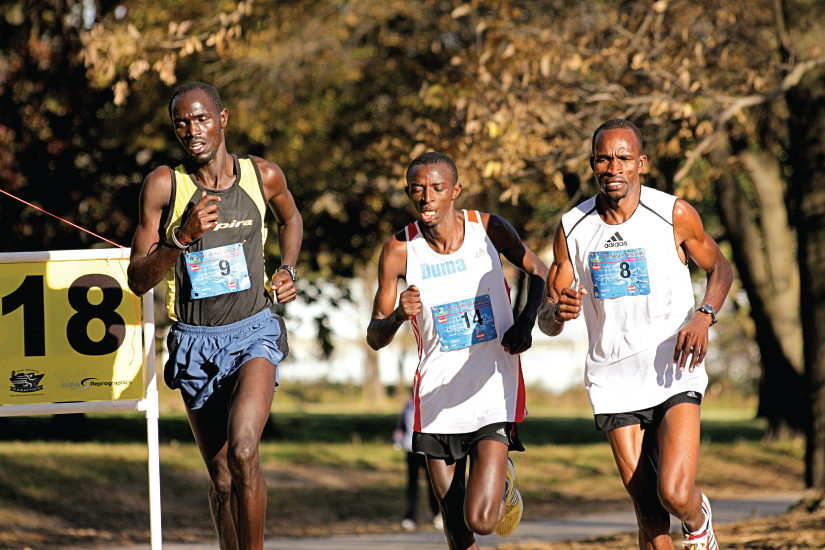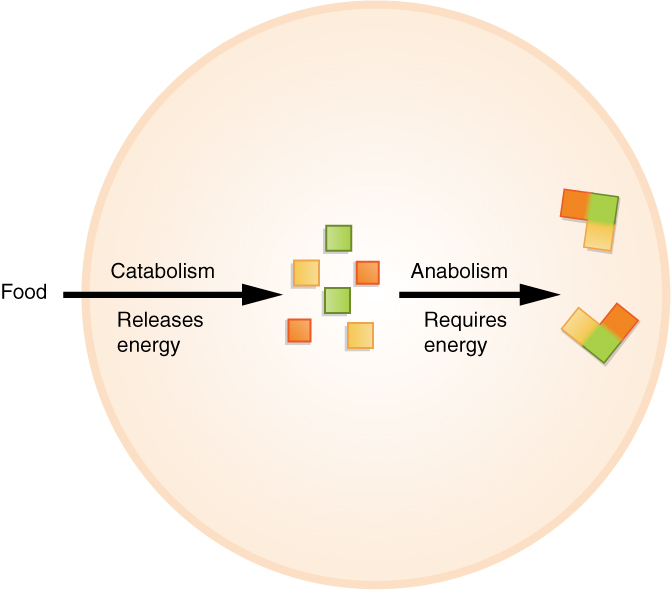Chapter 1
Introduction to Human Biology and the Scientific Process
1.2 Functions of Human Life
Objectives
By the end of this section, you will be able to:
-
Explain the importance of organization to the function of the human organism
-
Distinguish between metabolism, anabolism, and catabolism
-
Provide at least two examples of human responsiveness and human movement
-
Compare and contrast growth, differentiation, and reproduction
The different organ systems each have different functions and therefore unique roles to perform in physiology. These many functions can be summarized in terms of a few that we might consider definitive of human life: organization, metabolism, responsiveness, homeostasis, adaptation, movement, development, and reproduction.
Organization
A human body consists of trillions of cells organized in a way that maintains distinct internal compartments. These compartments keep body cells separated from external environmental threats and keep the cells moist and nourished. They also separate internal body fluids from the countless microorganisms that grow on body surfaces, including the lining of certain tracts, or passageways. The intestinal tract, for example, is home to even more bacteria cells than the total of all human cells in the body, yet these bacteria are outside the body and cannot be allowed to circulate freely inside the body.
Cells, for example, have a cell membrane (also referred to as the plasma membrane) that keeps the intracellular environment—the fluids and organelles—separate from the extracellular environment. Blood vessels keep blood inside a closed circulatory system, and nerves and muscles are wrapped in connective tissue sheaths that separate them from surrounding structures. In the chest and abdomen, a variety of internal membranes keep major organs such as the lungs, heart, and kidneys separate from others.
The body’s largest organ system is the integumentary system, which includes the skin and its associated structures, such as hair and nails. The surface tissue of skin is a barrier that protects internal structures and fluids from potentially harmful microorganisms and other toxins.
Metabolism
The first law of thermodynamics holds that energy can neither be created nor destroyed—it can only change form. Your basic function as an organism is to consume (ingest) molecules in the foods you eat, convert some of it into fuel for movement, sustain your body functions, and build and maintain your body structures. There are two types of reactions that accomplish this: anabolism and catabolism.
-
Anabolism is the process whereby smaller, simpler molecules are combined into larger, more complex substances. Your body can assemble, by utilizing energy, the complex chemicals it needs by combining small molecules derived from the foods you eat
-
Catabolism is the process by which larger more complex substances are broken down into smaller simpler molecules. Catabolism releases energy. The complex molecules found in foods are broken down so the body can use their parts to assemble the structures and substances needed for life.
Taken together, these two processes are called metabolism. Metabolism is the sum of all anabolic and catabolic reactions that take place in the body (Figure 1.4). Both anabolism and catabolism occur simultaneously and continuously to keep you alive.
Every cell in your body makes use of a chemical compound, adenosine triphosphate (ATP), to store and release energy. Think of ATP as the energy “currency” of the cell. If energy is needed for something to happen in the cell, then ATP is used to “pay the energy bill”. The cell stores energy in the synthesis
(anabolism) of ATP, then moves the ATP molecules to the location where energy is needed to fuel cellular activities. Then the ATP is broken down (catabolism) and a controlled amount of energy is released, which is used by the cell to perform a particular job.
Concept in Action
To learn more about metabolic processes watch the YouTube video below.
Responsiveness
Responsiveness is the ability of an organism to adjust to changes in its internal and external environments. An example of responsiveness to external stimuli could include moving toward sources of food and water and away from perceived dangers. Changes in an organism’s internal environment, such as increased body temperature, can cause the responses of sweating and the dilation of blood vessels in the skin in order to decrease body temperature, as shown by the runners in Figure 1.5.

Homeostasis
To function properly, cells require appropriate conditions such as proper temperature, pH, and concentrations of diverse chemicals. These conditions may, however, change from one moment to the next. Organisms are able to maintain internal conditions within a narrow range almost constantly, despite environmental changes, through a process called homeostasis or “steady state”—the ability of an organism to maintain constant internal conditions. For example, many organisms regulate their body temperature in a process known as thermoregulation. Organisms that live in cold climates, such as the polar bear, have body structures that help them withstand low temperatures and conserve body heat. In hot climates, organisms have methods (such as perspiration in humans or panting in dogs) that help them to shed excess body heat. As we discuss organ systems, the concept of homeostasis will be critically important to remember.
Adaptation
All living organisms exhibit a “fit” to their environment. Biologists refer to this fit as adaptation and it is a consequence of evolution by natural selection (i.e. survival of the fittest), which operates in every lineage of reproducing organisms. Examples of adaptations are diverse and unique, from heat-resistant bacteria that live in boiling hot springs to the tongue length of a nectar-feeding moth that matches the size of the flower from which it feeds. All adaptations enhance the reproductive potential of the individual exhibiting them, including their ability to survive to reproduce. Adaptations are not constant. As an environment changes, natural selection causes the characteristics of the individuals in a population to track those changes.
Movement
Human movement includes not only actions at the joints of the body, but also the motion of individual organs and even individual cells. As you read these words, red and white blood cells are moving throughout your body, muscle cells are contracting and relaxing to maintain your posture and to focus your vision, and glands are secreting chemicals to regulate body functions. Your body is coordinating the action of entire muscle groups to enable you to move air into and out of your lungs, to push blood throughout your body, and to propel the food you have eaten through your digestive tract. Consciously, of course, you contract your skeletal muscles to move the bones of your skeleton to get from one place to another (as the runners are doing in Figure 1.5), and to carry out all of the activities of your daily life.
Development, Growth and Reproduction
Development is all of the changes the body goes through in life. Development includes the processes of differentiation, growth, and renewal.
Growth is the increase in body size. Humans, like all multicellular organisms, grow by increasing the number of existing cells, increasing the amount of non-cellular material around cells (such as mineral deposits in bone), and, within very narrow limits, increasing the size of existing cells.
Reproduction is the formation of a new organism from parent organisms. In humans, reproduction is carried out by the male and female reproductive systems. Because death will come to all complex organisms, without reproduction, the line of organisms would end.
Section Summary
Most processes that occur in the human body are not consciously controlled. They occur continuously to build, maintain, and sustain life. These processes include: organization, in terms of the maintenance of essential body boundaries; metabolism, including energy transfer via anabolic and catabolic reactions; responsiveness; homeostasis; adaptation; movement; and growth, differentiation, reproduction, and renewal.
Key Terms
- anabolism
- assembly of more complex molecules from simpler molecules
- catabolism
- breaking down of more complex molecules into simpler molecules
- development
- changes an organism goes through during its life
- differentiation
- process by which unspecialized cells become specialized in structure and function
- growth
- process of increasing in size
- metabolism
- sum of all of the body’s chemical reactions
- renewal
- process by which worn-out cells are replaced
- reproduction
- process by which new organisms are generated
- responsiveness
- ability of an organisms or a system to adjust to changes in conditions

